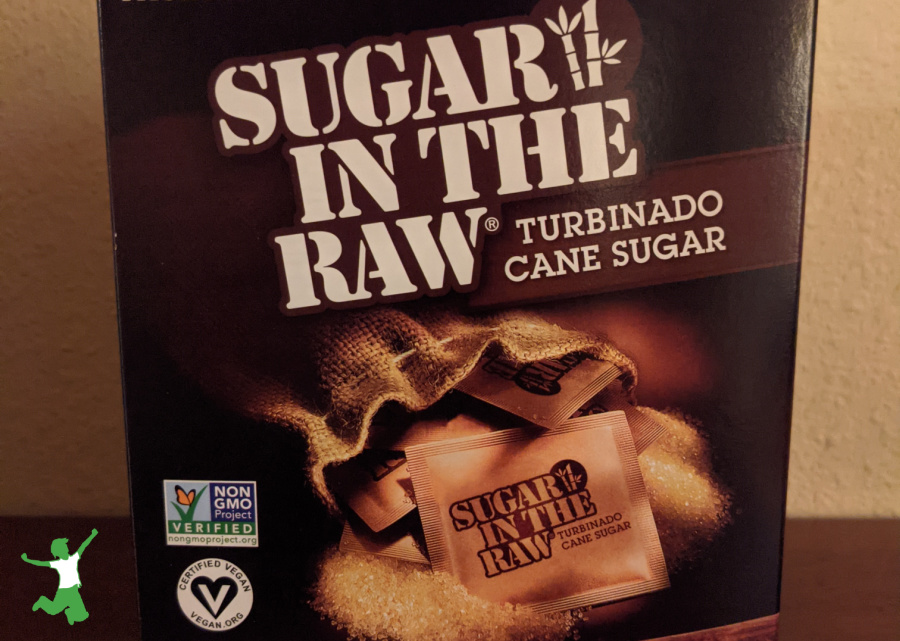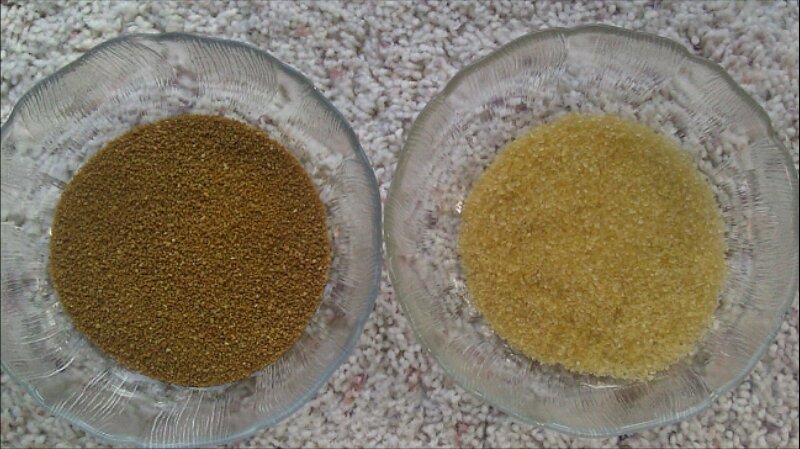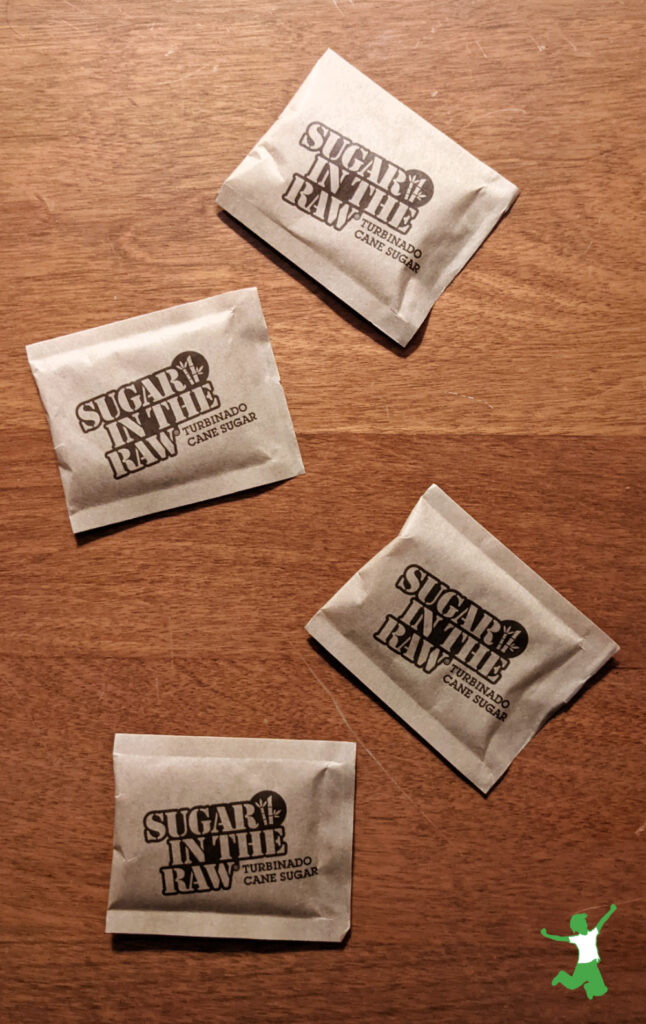Examination of the marketing claim of Sugar in the Raw and whether it is a whole, unprocessed sweetener retaining all the minerals of raw cane juice.

If a food is labeled as “raw”, what exactly does that mean?
To a consumer like me, raw means that the food is completely unadulterated. It has not in any way changed from its original natural form.
In other words, nothing has been added, removed, or heated to a temperature that would change any of the inherent nutritional characteristics.
Unfortunately, to food manufacturers, the definition of “raw” can be quite different.
In fact, raw to Big Food can translate to highly processed, industrialized food!
I’ve written before about how most raw cheese at the store is not raw at all in reality! In addition, cold-pressed raw milk and cold-pressed juice are not actually fresh either.
Sugar in the Raw Marketing Ploy
Another fake raw food at the store that is fooling a whole lot of people is “Sugar in the Raw”. It is also known as turbinado sugar or natural cane sugar.
But what about the “Good Housekeeping” seal of approval that sometimes appears on the box?
Doesn’t that mean that the Sugar in the Raw product is legitimate and to be trusted in its labeling claims?
Apparently not. Here’s what the manufacturer of Sugar in the Raw has to say about its product:
Enjoy sweet moments naturally with Sugar In The Raw®, our all-natural Turbinado sugar grown in the tropics. The hearty, golden crystals are never bleached, so they keep the rich flavor and color of their natural molasses. So go on, stir it in or sprinkle it on. Bake and cook with it too. Whatever you do, just do it naturally with Sugar In The Raw®.
It seems that just because Sugar in the Raw is unbleached makes it raw.
Perhaps that is what the USDA allows when it comes to labeling sugar products.
To me, sugar that is truly raw means much more than just unbleached. It means that nothing has been removed or added as well.
The marketing of this product is so sneaky because it leads the consumer to believe that the natural molasses is intact.
And, for Sugar in the Raw, a small amount of the molasses is indeed intact because it is a darker color than white sugar.
The truth, however, is that MOST of the molasses HAS been stripped away.
Comparison to Sucanat

Check out the picture above which shows a bowl of Sugar in the Raw next to a bowl of sucanat.
Notice the dark brown color of sucanat which is truly unprocessed cane sugar with all minerals, nutrients and molasses intact.
The lighter color of Sugar in the Raw indicates that the manufacturer has removed much of the mineral content.
In other words, the much darker sucanat visually demonstrates that Sugar in the Raw is a fake food masquerading as real.
It is an adulterated product contrary to the sneaky claims by the manufacturer.
What is the Best Cane Sugar?
Looking for the best and most nutritious form of cane sugar for your homemade cookies and cakes?
Sucanat is it! It is the best alternative to white or brown sugar substituted 1:1 in all your recipes.
It is best to bypass Sugar in the Raw or other turbinado sugar brands.
Florida Crystals is another cane sugar brand missing most of the molasses, so beware!
Most White or Brown Sugar is GMO
Another HUGE problem to watch out for is that most white or brown sugar in North America is partially or totally beet sugar. This sweetener is nearly always GMO unless certified organic.
GMO beet sugar is visually and taste-wise completely indistinguishable from white cane sugar.
Is beet sugar healthy? While it may seem so because it comes from a vegetable, the truth is that it is not!
Sugar from sugar beets is nutritionless and contaminated with gut-destroying glyphosate residue. Nearly 100% of farmers growing it use Monsanto’s Roundup Ready sugar beets.
A package of sugar must specifically state that the sweetener is cane sugar or be certified organic, else it is almost certainly a mixture that is wholly or partially GMO beet sugar.
Even brown sugar commonly contains at least some white beet sugar mixed with cane sugar molasses. The molasses from sugar beets is not fit for consumption.
To get the real thing, look for sucanat or sugarcane jaggery. Both are simply dried cane sugar juice with all minerals intact.
Ancestral cultures in India enjoyed these sweeteners for thousands of years.
What is a Safe Level to Consume?
While sucanat is your best choice when trying to find a truly natural and unprocessed substitute for processed cane sugar, be careful not to overdo.
Eating too much sugar can lower immunity, even if natural and unprocessed, in a manner similar to white sugar or partially processed sweeteners like Sugar in the Raw.
In summary, it always pays big dividends to do a little checking before buying into any labeling claims.
Sugar in the Raw is just another clever marketing scheme designed to make money off of consumers who genuinely are trying to improve their diets but don’t have quite enough information to make a completely informed decision.
Where to Find Truly Unprocessed Natural Sweeteners
Need help identifying truly natural, unprocessed whole sweeteners?
Please visit my Shopping Guide for a vetted list of vendors I buy from who offer quality sucanat, jaggery, coconut sugar, raw honey, maple syrup, and other wholesome sweeteners.
Beware that popular “healthy” sweeteners like xylitol and other sugar alcohols as well as brown rice syrup used in many organic foods and baby formula are highly processed. This is why making homemade baby formula is a better choice than commercial brands.









I am just curious, I use sugar in the raw and I was wondering if coloring was the only thing you were referring to? I have noticed that sometimes, the sugar in the raw is very dark, while others it is not as dark, but it is always some shade of “caramel” what would account for this? Surely there are differences between canes, temperatures, processes etc? Otherwise why would there be variations even among the same brand? At the end of the day, our bodies are not meant to process large amounts of sugar (no matter how “raw” or “processed” they are). If you look at history, sweet things were very difficult to get, which is why are brains are hard wired to love them so much. They have (if you believe in evolution, which personally, I do) always been a rare treat so to speak. That is why they are addicting (and I mean that literally. They trigger the same reward center in our brains that heroin and cocaine do!) and why there seems to be an epidemic of obesity, because something that used to be hard to come by is all of a sudden in great abundance and getting more and more concentrated as time goes on…. Metabolically, your body does know the difference between honey, molasses, fruits, or cane sugar (raw or otherwise). To your body, they are all simple carbohydrates. The only thing that really matters is that with eating fruit, you get some fiber which helps your body process the simple carbohydrates and remove it from your intestines, which is why drinking a glass of OJ every morning isn’t as good for you as eating an actual orange. Sugar, in large, quantities is bad for you.
The only difference between sugar in the raw and sucanat is that one has been washed, removing the surface molasses and making it more suitable for instances calling for white sugar and The other hasn’t, making it more suitable where brown sugar is called for.
There is nothing unnatural about it.
Hey! I simply would like to give a huge thumbs up for the great information you will have here on this post.
I will be coming back to your weblog for more soon.
Sugar In The Raw is the name of the brand. That’s why there is the registered symbol next to the name. It isn’t saying, nor does it state anywhere on the box that it is RAW sugar. It does say it is turbinado sugar which is still a lot less processed than the white table sugar you buy from the grocery store.
The company doesn’t say it is unadulterated. Yes, Sucanat is darker because it is not processed at all, but again, Sugar in the Raw never says it isn’t processed so there is nothing sneaky about their marketing.
Sugar cane is pressed to extract the juice to make turbinado sugar. It is then heated to remove roughly 1/2 of the molasses, then spun in a centrifuge to dry it. There are no solvents or bone meal used in turbinado sugar. Since 1/2 (or more) of the molasses is still in tact, there are still some vitamins and minerals left in the sugar. http://www.emmshealthyliving.com/sugars/
Is it as healthy as Sucanat sugar? No, but it’s not as bad as what you’re trying to make it out to be. And by me saying ‘as healthy as Sucanat,’ I’m not implying that I think sugar has any extreme health benefits.
I believe this is where a big problem lies; blogs posting articles that aren’t entirely true and that causes others to become even more confused. I understand you want to make money by linking to your affiliate account on amazon for Sucanat sugar, but please rethink misleading people as you accuse a company of doing.
I use sugar in the raw, not because it’s “natural”….but because white sugar, along with sugar substitutes hurt my stomach when I use them. Nothing is bad in moderation….that’s the key. Agave syrup is my go to most of the time, however, my grocery store is spotty about what and when they carry an item. Perhaps, more “investigating” by us consumers is the key….rather than believing what is freely available, an unreliable.
Is Morena sugar raw sugar? The package says “Morena PURE CANE SUGAR” “ALL NATURAL/GREAT TASTE”.
“Zulka Morena is an all natural, unrefined and NON-GMO pure cane sugar that is made by squeezing and evaporating the juice from freshly harvested sugar cane.
The result is a golden sweet srystal that tastes like biting into fresh sugar cane.”
I just picked up a 2 pound bag at my local store in the Hispanic food aisle for $1.89.
It seems to me that “In the Raw” is only the trademark and not really a guarantee of what the product is. Of course this leads to sales by confusing the public and though this is a technique used in marketing, if it is not truly raw, it is a dirty strategy since as I have mentioned before, it confuses people. This may be the only explanation why it is approved, as they can justify that the mention of the “raw” is only their brand name, and not necessarily the product they are selling. Would have to read the small letters to confirm all these, but this is what I suspect.
I agree with Iniquity. All this is about false labeling. So many companies are labeling their products raw when they are not. Along the lines of the raw sugar debate, “Wholesome Sweetners” is labeling their Organic Turbinado Sugar “Raw” but if you read about their processing they heat the sugar syrup before they evaporate it. So I doubt it is really raw in the finished product. Also many nut butter companies label their nut butters “raw” (Maranatha is one) but they aren’t in the finished product. They start out with raw nuts, but the grinding temperatures are high enough to render the final product cooked! We need truth in labeling so we can make informed choices. The reason we don’t have truth in labeling is Greed.